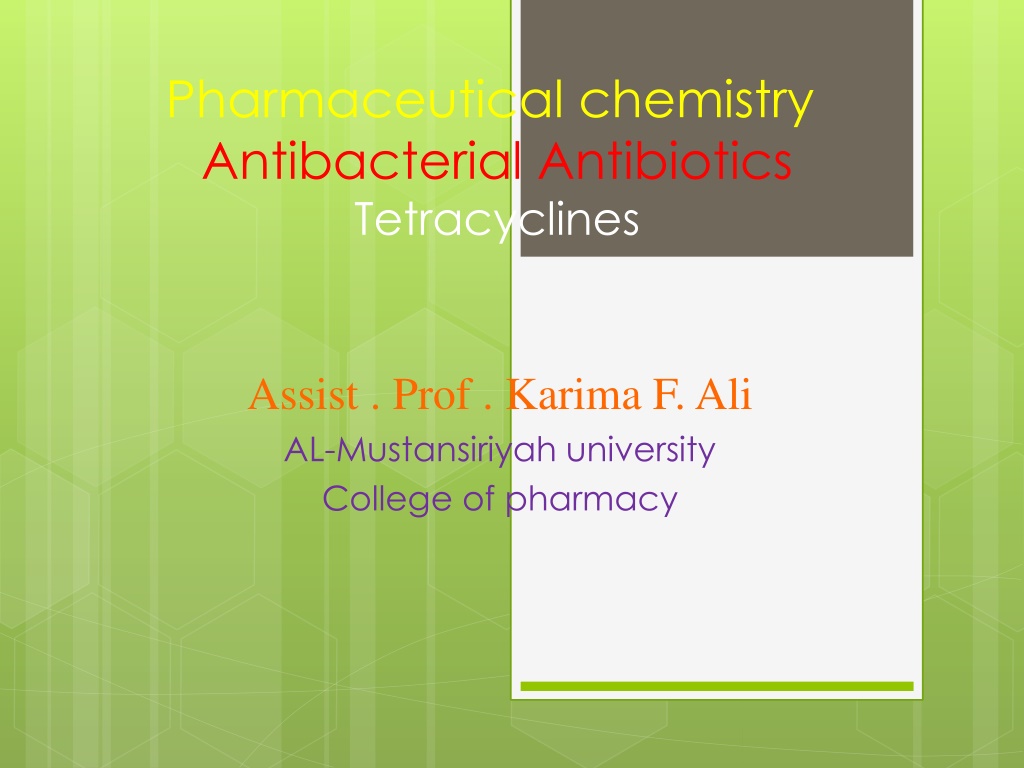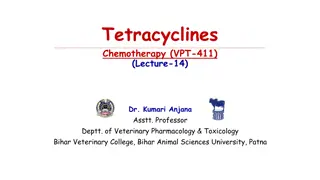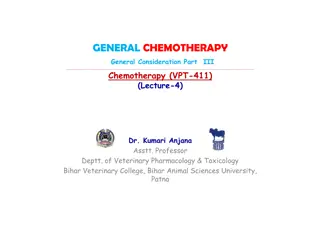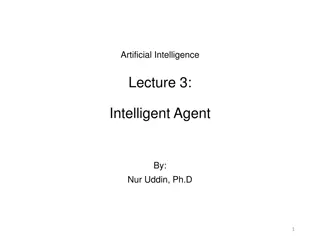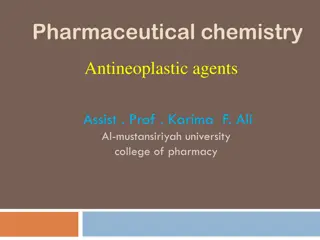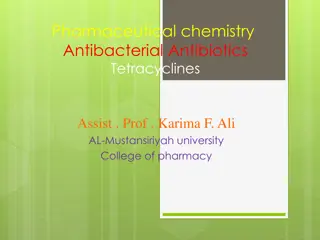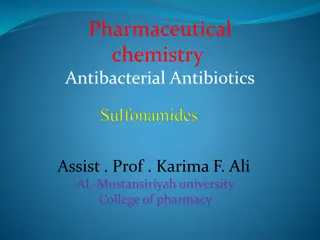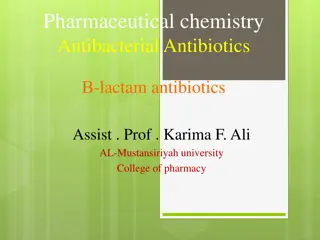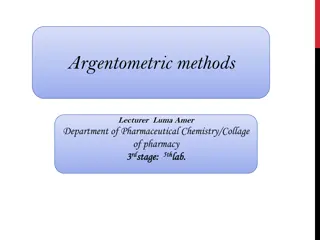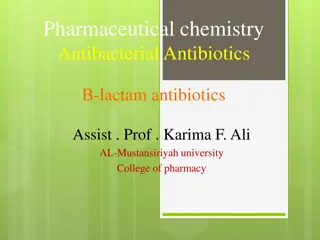Understanding Tetracyclines: Antibacterial Agents in Pharmaceutical Chemistry
Tetracyclines, a group of broad-spectrum antibiotics, play a vital role in pharmaceutical chemistry. This article delves into the complex stereochemistry, structures, and reactivity of tetracyclines, highlighting their importance in combating bacterial infections. Explore the unique characteristics and modifications of these antibiotics for enhanced efficacy and stability.
Download Presentation

Please find below an Image/Link to download the presentation.
The content on the website is provided AS IS for your information and personal use only. It may not be sold, licensed, or shared on other websites without obtaining consent from the author. Download presentation by click this link. If you encounter any issues during the download, it is possible that the publisher has removed the file from their server.
E N D
Presentation Transcript
Pharmaceutical chemistry Antibacterial Antibiotics Tetracyclines Assist . Prof . Karima F. Ali AL-Mustansiriyah university College of pharmacy
Chemistry Among the most important broad-spectrum antibiotics are members of the tetracycline family. Nine such compounds tetracycline, oxytetracycline, chlortetracycline, meclocycline, methacycline, minocycline have been introduced into medical use. Several others possess antibiotic activity. The tetracyclines are obtained procedures from Streptomyces spp. or by chemical transformations of the natural products rolitetracycline, demeclocycline, doxycycline, and by fermentation
The stereochemistry of the tetracyclines is very complex. Carbon atoms 4, 4a, 5, 5a, 6, and 12a are potentially chiral, depending on substitution. Oxytetracycline and doxycycline, each with a 5 - hydroxyl substituent, have six asymmetric centers; the others, lacking chirality at C-5, have only five.
Structure of the Tetracyclines The tetracyclines are amphoteric compounds, forming salts with either acids or bases. In neutral solutions, these substances exist mainly as zwitterions. The unusual structural groupings in the tetracyclines produce three acidity constants in aqueous solutions of the acid Salts (pKa1 pKa2 pKa3).
Strong acids and strong bases attack tetracyclines with a hydroxyl group on C-6, causing a loss in activity through modification of the C ring. Strong acids produce dehydration through a reaction involving the 6-hydroxyl group and the 5a-hydrogen. The double bond thus formed between positions 5a and 6 induces a shift in the position of the double bond between C-11a and C-12 to a position between C-11 and C-11a, forming the more energetically favored resonant system of the naphthalene group found in the inactive anhydrotetracyclines.
Bases promote a reaction between the 6- hydroxyl group and the ketone group at the 11-position, causing the bond between the 11 and 11a atoms to cleave, forming the lactone ring found in the inactive isotetracycline. These two unfavorable reactions stimulated research that led to the development of the more stable and longer acting compounds methacycline, doxycycline, and minocycline. 6-deoxytetracycline,
Base Acid
Stable tetracyclines with many metals, including calcium, magnesium, and iron. Such chelates are usually very insoluble in water, accounting for the impaired absorption of most (if not all) tetracyclines in the presence of milk; calcium-, magnesium-, and aluminum-containing antacids; and iron salts. Soluble alkalinizers, such as sodium bicarbonate, also decrease the GI absorption of the tetracyclines. The affinity of tetracyclines for calcium causes them to be incorporated into newly forming bones and teeth as tetracycline calcium orthophosphate complexes chelate complexes are formed by the
Mechanism of Action and Resistance Tetracyclines are specific inhibitors of bacterial protein synthesis. They bind to the 30S ribosomal subunit and, thereby, prevent the binding of aminoacyl tRNA to the mRNA ribosome complex. Three biochemically distinct mechanisms of resistance to tetracyclines have been described in bacteria: (a) efflux mediated by trans membrane-spanning, active- transport proteins that reduces the intracellular tetracycline concentration (b) ribosomal protection, in which the bacterial protein synthesis apparatus is rendered resistant to the action of tetracyclines by an inducible cytoplasmic protein (c)enzymatic oxidation.
Spectrum of Activity The tetracyclines have the broadest spectrum of activity of any known antibacterial agents. They are active against a wide range of Gram-positive and Gram-negative bacteria, spirochetes, mycoplasma, rickettsiae, and chlamydiae. Resistance to tetracyclines among both Gram-positive and Gram-negative bacteria is relatively common.
StructureActivity Relationships 1. All derivatives containing fewer than four rings are inactive or nearly inactive. 2. The simplest tetracycline derivative that retains the characteristic broad-spectrum activity associated with this antibiotic class is 6-demethyl-6-deoxytetracycline. 3. The enolized tricarbonylmethane system at C-1 to C-3 must be intact for good activity. 4. Replacement of the amide at C-2 with other functions (e.g., aldehyde or nitrile) reduces or abolishes activity. 5. Mono alkylation of the amide nitrogen reduces activity proportionately to the size of the alkyl group.
6. The dimethyl amino group at the 4-position must have the - orientation: 4-epitetracyclines are very much less active than the natural isomers. 7. Removal of the 4-dimethylamino group reduces activity even further. 8. Activity is largely retained in the primary and N-methyl secondary amines but rapidly diminishes in the higher alkylamines. 9. A cis-A/B-ring fusion with a -hydroxyl group at C-12a is apparently also essential. 10. Esters of the C-12a hydroxyl group are inactive, with the exception of the formyl ester, which readily hydrolyzes in aqueous solutions. 11.Alkylation at C-11a also leads to inactive compounds
12. Dehydrogenation to form a double bond between C-5a and C-11a markedly decreases activity, as does aromatization of ring C to form anhydrotetracyclines. 13. substituents at positions 5, 5a, 6, 7, 8, and 9, representing the largely hydrophobic northern and western faces of the molecule, can be modified with varying degrees of success, resulting in retention and, sometimes, improvement of antibiotic activity. 14. A 5-hydroxyl group, as in oxytetracycline and doxycycline, may influence properties but does not change antimicrobial activity. pharmacokinetic
15. Acid-stable 6-deoxytetracyclines and 6- demethyl- 6-deoxytetracyclines have been used to prepare various mono substituted and di substituted derivatives by electrophilic substitution reactions at C-7 and C-9 of the D ring. 16. The more useful results have been achieved with the introduction of substituents at C-7. 17. Oddly, strongly electron withdrawing groups (e.g., chloro [lortetracycline] and electron-donating groups [minocycline]) enhance activity. nitro) and strongly amino (e.g., dimethyl
18. modification of the tetracyclines has been the 6- position. Neither the 6 -methyl nor the 6 -hydroxyl group is essential for antibacterial activity. 19. Polar substituents (i.e., hydroxyl groups) at C-5 and C-6 decrease lipid versus water solubility of the tetracyclines. The 6-position is, however, considerably more sensitive than the 5-position to this effect. Nonpolar substituents have the opposite effect. The most fruitful site for semisynthetic
Products Tetracycline Tetracycline has become the most popular antibiotic of its group, largely because its plasma concentration appears to be higher and more enduring than that of either oxytetracycline or chlortetracycline.
Rolitetracycline Chlortetracycline Hydrochloride oxytetracycline methacycline
The greater stability of methacycline, both in vivo and in vitro, results from modification at C-6. Removal of the 6-hydroxy increases the stability of ring C to both acids and bases, preventing the formation of isotetracyclines by bases. group markedly
Doxycycline 6 Doxycycline, -6-deoxy-5-oxytetracycline (Vibramycin). The 6 -methyl epimer is more than 3 times as active as its -epimer. Apparently, the difference in orientation of the methyl groups, which slightly affects the shapes of the molecules, causes a substantial difference in biological effect.
absence of the 6-hydroxyl compound that is very stable in acids and bases and that has a long biological half-life. In addition, it is absorbed very well from the GI tract, thus allowing a smaller dose to be administered group produces a
Minocycline Hydrochloride Minocycline, 7-dimethylamino-6-demethyl-6- deoxytetracycline (Minocin, Vectrin), the most potent tetracycline currently used in therapy, is obtained by reductive methylation of 7-nitro-6-demethyl-6-deoxytetracycline. Because minocycline, like doxycycline, lacks the 6-hydroxyl group, it is stable in acids and does not dehydrate or rearrange to anhydro or lactone forms. It has a very long serum half-life, resulting from slow urinary excretion and moderate protein binding.
Newer tetracyclines substituted in the aromatic (D) ring in an effort to discover analogs that might be effective against resistant strains. Glycylcyclines, a class of 9-dimethylglycylamino-(DMG)- substituted tetracyclines were discovered. The first of these to be marketed was tigecycline.
